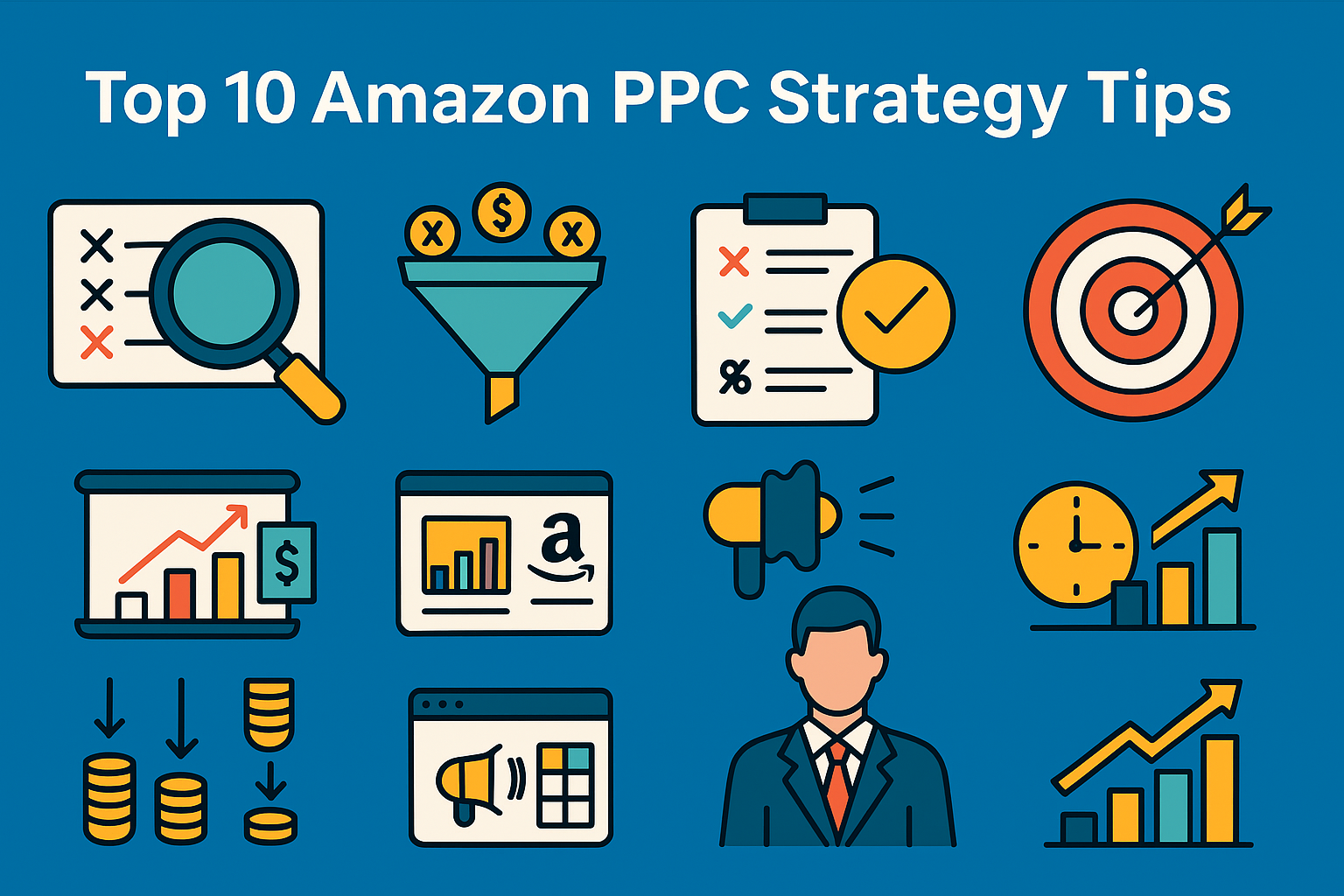- Perfality
- June 20, 2025
- 2:13 pm
- Read Time: 5 mintues
If you’ve been running ads on Amazon lately, you already know—it’s not the wild west anymore. Clicks are getting pricier, competition is turning cutthroat, and customer behaviour is changing. Let’s just say, it’s evolving faster than most sellers can keep up with.
In 2025, you can’t afford to “test and pray.” You need a clear, well-structured Amazon PPC strategy that’s built around your margins, your goals, and how your actual customer’s shop.
At Perfality, we’ve had our hands in dozens of ad accounts—from niche brands just starting out to large catalogs scaling across international marketplaces. What follows isn’t a list of recycled tips. These are real strategies we’ve used, refined, and seen work.
Let’s break them down.
1. Stop Using Stale Keyword Lists
Here’s the truth, most sellers add a few keywords from a research tool, maybe toss in some from a competitor’s listing, and just… leave them. For months.
That’s not a strategy. That’s a budget drain.
Instead, think of your keyword list like fresh produce, it needs regular attention. Every couple of weeks, dig into your search term reports. What’s converting? What’s just eating up you spend? We’ve had clients who cut their ACoS by over 20% just by pruning out irrelevant terms and doubling down on what actually moves product.
2. Funnel Your Campaigns (and Think Like a Buyer)
Too many sellers treat campaign types as interchangeable. They’re not.
Here’s what we’ve learned:
- Broad match works well for discovery—but it’s noisy.
- Phrase match helps tighten the focus.
- Exact match is where the sales usually live.
Structure your Amazon PPC campaign strategy like a funnel. Start broad, analyze the data, and filter your winners into exact match groups with focused budgets. The goal? Let your campaigns guide spend toward what works, not what just looks good on a dashboard.
3. Don’t Ignore the Junk—Clean It Up Weekly
This might be the most human part of PPC: maintenance.
And it’s where most sellers fall short.
If a keyword hasn’t converted after a few dozen clicks, it’s not a “maybe.” It’s dead weight. Add it to your negatives and move on.
We had one partner who unknowingly burned through nearly $2,000 in a single month on underperforming search terms—terms that should’ve been paused after the first week. A quick audit turned that around, and within 10 days, their spend was leaner and their conversions were up by 17%.
4. Sponsored Brands & Display Ads Are Seriously Underused
Let’s talk about something a lot of sellers overlook—Sponsored Brand and Sponsored Display campaigns.
If you’re only using Sponsored Products, you’re basically whispering in a crowded room. Sponsored Brand ads (you know, those top-of-search banners with your logo and a bold message?) help people remember your brand, not just your product. They work incredibly well, especially when you’re pushing multiple variations or trying to dominate a category.
And Sponsored Display? That’s your shot at retargeting shoppers—even after they leave Amazon. As part of an effective Amazon PPC launch strategy, using these ad types early can give you a real leg up.
5. Set Real Goals—“Get More Sales” Doesn’t Count
Ask ten sellers why they’re running PPC and you’ll hear the same thing: “to get more sales.”
Sure. But how?
A well-planned Amazon PPC strategy ties each campaign to a goal that you can actually measure—visibility, conversions, ranking a new ASIN, clearing old stock. One of our clients ran campaigns with three different goals at once, each structured differently. That’s how we kept performance clean and knew exactly what was driving what.
Want better results? Start by knowing what success looks like before you hit “Launch.”
6. Let Your Data Tell You Where to Bid
Here’s something we see all the time: brands bidding the same across every placement. Not smart.
Amazon gives you performance data by placement—top of search, rest of search, and product pages. You’ll usually find that top-of-search converts best, even if it costs more.
That’s where bid adjustments come in.
If you notice that your top-of-search ads are bringing in double the sales of your others, raise your multiplier there. No need to boost your whole campaign budget—just give the best slots more juice.
This trick alone has helped several brands scale their Amazon FBA PPC strategy without overspending.
7. Don’t Just Let Auto Campaigns Run Wild
Auto campaigns are like interns: they’ll either find gold or burn time—depends on how closely you supervise them.
Yes, they’re helpful for keyword discovery. But here’s the catch: they also love to waste budget if you’re not watching. The fix? Set a modest budget, monitor performance, and move winners into manual campaigns. Then block the losers with negative keywords.
If you treat auto campaigns like a lab—not a long-term strategy—you’ll get the best of both worlds: discovery and control. That’s a core piece of optimizing Amazon PPC.
8. Track ACoS, Yes—but Don’t Ignore TACoS
If you’re only watching ACoS, you’re missing half the story.
ACoS tells you how well your ads are performing in isolation. But TACoS (Total Advertising Cost of Sales) shows how your ads affect everything—including your organic sales. If your TACoS is going down while sales are going up, congratulations—your ads are lifting the whole business.
One of our partners launched a series of campaigns with ACoS in the high 30s, but over time, their TACoS dropped below 10%. That’s because their visibility improved and their organic rank caught fire.
A solid Amazon PPC campaign strategy watches both. That’s how you scale smart, not just fast.
9. Run Ads When Shoppers Are Actually Buying
Here’s a quick win that many sellers miss: dayparting.
Not all hours perform equally. Ads that run overnight might chew up your budget without converting. By analyzing when your shoppers actually buy—think evenings, weekends, payday windows—you can schedule your ads to hit when it matters.
For one account, we cut wasted ad spend by nearly 20% simply by turning off low-converting hours. That small shift made their Amazon FBA PPC strategy way more efficient.
10. If It’s Too Much to Manage, Get Help
Amazon PPC used to be manageable with a few SKUs and manual tweaks. In 2025? It’s a different game.
Between bidding rules, keyword clean-up, placement controls, and ever-changing ad types, it’s easy to miss opportunities—or worse, burn cash.
That’s where a trusted Amazon PPC agency comes in. At Perfality, we work behind the scenes to build custom campaign frameworks, identify waste, and make sure your budget is moving the needle. Whether you’re launching or scaling, smart strategy and experienced eyes make all the difference.
Final Thoughts: Smarter PPC, Stronger Results
Let’s face it—Amazon ads in 2025 are not about who spends the most. They’re about who adapts the best.
A successful Amazon PPC strategy today means knowing your goals, trimming the waste, refining your targeting, and using every tool (auto campaigns, dayparting, placements, ad types) like a pro.
And most importantly? It means checking in often. The brands we see winning aren’t perfect—they’re just consistent.
If you’re looking to sharpen your Amazon PPC launch strategy, clean up performance, or finally get some breathing room in your ad workflow…
Let’s talk.
Perfality helps sellers like you simplify, scale, and succeed with smart Amazon FBA PPC strategy support—so you can focus on growth, not guesswork.






